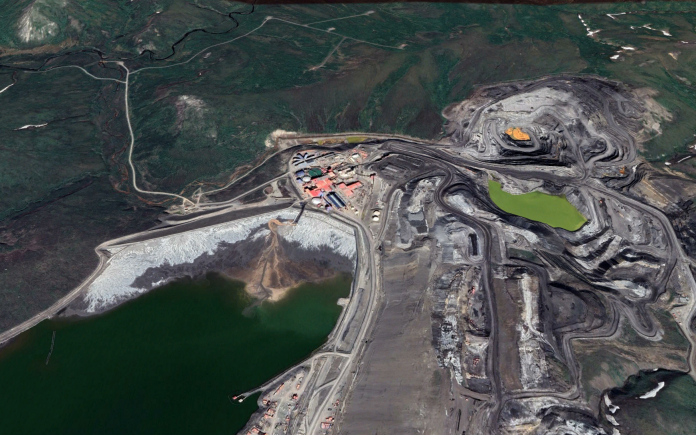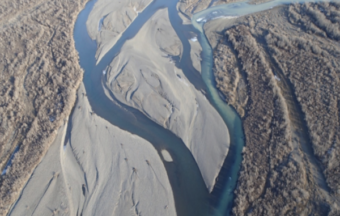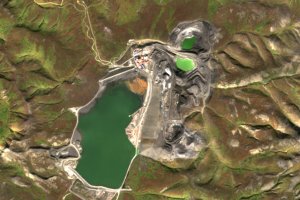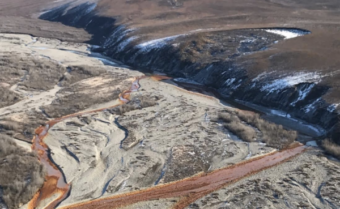
The multinational company that operates the massive Red Dog Mine in Northwest Alaska says thawing permafrost linked to global warming has forced it to spend nearly $20 million to manage its water storage and discharge.
The problems at Red Dog, one of the world’s largest zinc mines, show how climate change poses a challenge not just to residents of Arctic Alaska, but also to the economy of the region, which is warming at triple the rate of the global average.
Vancouver-based Teck Resources Ltd. says that permafrost thaw in the watershed surrounding Red Dog is releasing higher natural levels of dissolved minerals and other particles into streams. That, in turn, has limited the mine’s ability to discharge its own treated wastewater into a nearby creek, causing water to back up in its tailings reservoir.

Red Dog can only discharge from the reservoir when the creek’s naturally occurring levels of “total dissolved solids” are below a certain threshold, said Wayne Hall, community and public relations manager for the mine. That threshold, he added, had never been exceeded before the summer of 2019, which saw record high warmth.
“In 30 years of Red Dog operation, this is the first time that we’ve ever seen background levels in the creeks to the point where it precluded us from discharging,” Hall said in an interview.
Last week, following the construction of a new wastewater treatment system that uses reverse osmosis, Red Dog resumed discharging.
But while the system was being built, Teck had to take an array of steps to keep water levels in the reservoir from getting too high.
Those steps included pumping hundreds of millions of gallons of water out of the reservoir into the bottom of Red Dog’s active mining pit, which forced Teck to mine lower-grade ore toward the top of the pit rather than the higher-grade ore at the bottom.
Red Dog also removed tens of millions of gallons more from the reservoir by freezing it into an icefield and accelerated a planned boost to the height of the dam.
Hall declined to say precisely how much Teck was spending on those measures. But in a call with investors last month, a Teck official said the cost was in the range of $19 million.

The challenges at Red Dog mark the latest example of how climate change is disrupting the resource development projects that are economic engines in parts of Arctic Alaska.
Last year, amid record high river levels on the North Slope, the company that operates the trans-Alaska oil pipeline had to spend more than $10 million on flood repairs. And oil companies are contending with shorter winters that threaten the ice roads needed to allow work on sensitive tundra.
NANA Regional Corp., the Alaska Native-owned corporation that leases the mine property to Teck, says the challenges at Red Dog could also hold lessons for Northwest Alaska residents and their local infrastructure — like if villages encounter similar problems with their drinking water.
“We need to be thinking about what these impacts may mean for communities,” said Liz Cravalho, NANA’s vice president of lands. “I think there are lessons to be learned in this situation that can be shared.”
Red Dog started up in 1989, in a unique partnership between NANA and Teck. It generated $1.6 billion in revenue last year and $700 million in gross profits, according to Teck.
The mine is 80 miles north of the Northwest Alaska hub town of Kotzebue. Since it began operating, it’s been credited with bringing economic activity and jobs to the region and to NANA’s indigenous shareholders.
NANA shareholders have earned a combined $500 million working at Red Dog, the corporation says. And payments in lieu of taxes from the mine account for between 80% to 90% of the Northwest Arctic Borough’s annual budget.
At the same time, conflicts have periodically erupted around the mine’s wastewater discharge, which was the subject of a 2002 lawsuit by residents of the village of Kivalina, 50 miles away. Water from Red Dog Creek ultimately drains into the Wulik River, which Kivalina residents use for subsistence fishing and drinking water.
The new discharge-related problems at Red Dog come as temperatures in the surrounding Northwest Arctic Borough have risen sharply. The borough’s annual average temperature was about 20.5 F in 1990. It’s risen about 5 degrees since, according to Rick Thoman, climate specialist at the Alaska Center for Climate Assessment and Policy.
The warming appears to be causing permafrost to thaw, which releases more sediments and minerals into the watershed upstream of Red Dog, said Hall, the mine official. And that theory aligns with what one Alaska permafrost expert says scientists are observing in the region.
During the summer, soil is thawing to deeper and deeper depths, while during winters, it’s freezing at shallower levels, said Vladimir Romanovsky, a professor at the University of Alaska Fairbanks’ Geophysical Institute. Scientists think that’s allowing more water to flow through the soil and move sediments into creeks and streams and rivers, he said.

Sediments also move much more easily when they’re not frozen, Romanovsky added.
“I think that’s the natural process happening because of steadily warming climate, and deeper and deeper thawing permafrost,” he said.
Recent state helicopter surveys of the watershed surrounding Red Dog have documented unusual levels of cloudy water in area streams that, in one case, interfered with fish counts by the Alaska Department of Fish and Game.
While global warming appears to present an increasing threat to both Alaska communities and businesses, with public infrastructure costs projected in the billions of dollars, Gov. Mike Dunleavy’s administration has downplayed the significance of the problem. Last year, the governor disbanded a task force charged with guiding Alaska’s response to climate change — though the state departments of environmental conservation and natural resources have closely tracked Red Dog’s water problems and issued weekly status reports.
Teck announced in February that it aims to be carbon neutral by 2050. And the company, on its website, says that climate change “requires decisive global action to address.”
“Personally, I think there’s things that we can all do,” Hall said. “And I’m quite proud of a company that’s willing to put their commitments down in writing about what we’re doing to try to combat climate change.”
